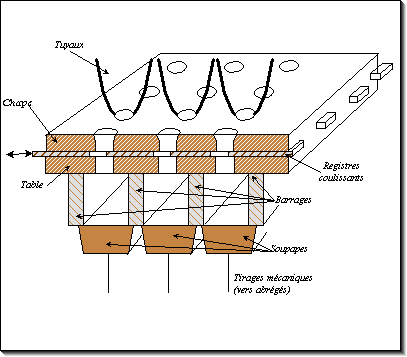MECANICAL TRACKER
SYSTEMS AND "UNIT" BODY: COMPARISSION
French version


Mechanical body:
Perspective view:
Air pressure entrance between "barrages" introduces
an important time dealy, and lazy attacks.
Moreover, pipe control are addressed by row
(stops) and columns (notes)
A random pallet control is impossible.
On the contrary, electronic control can open
any pallet from any notes and stop control.
-
Sets including bodies + registers involves
often failures.
-
Moreover, displacements betwen barrages and table
are frequent.
even on new pipe Organs. Manufacturers hardly
suppress these defaults by little hole at the Pipe bottom.
-
Mechanical tracking introduces an important inertia
for teh keyboard touch, due to the transmission weights.
(mechanical or pressure based).
 "UNIT
SYSTEM BODIES"
"UNIT
SYSTEM BODIES"
and electronic control:
-
Electronic control can either be adapted to mechanical
or unit type Organs.
-
Any pallet(s) can be opened from any note
-
New virtual stops can be computed, using
always real pipes, i.e. mixtures
for example: plein jeu, computed on the "prestant" and "flute", with exclusively
real Pipes.
-
Time delay suppression between pallet opening
and air introduction.
For anches, a short tube can be introduced, for
softening sound emission.
-
Progressive control possibility by
using 2 magnets
-
Register suppression , more simple bodies:Pipes
are directly put on tables and electronically controlled.
-
No longer barrages (no longer glue with table)
-
Mechanical parts suppression (abrégés,
vergettes)
-
Only one mobile part: pallet + magnet iron.
Summary:
-
Increased fiability, drastic cost reduction, volume
reduction,
-
Any pallet(s) can be opened from
any note
-
No longer costly mechanical or air-based transmissionssystems
(barker style)
For stops and note controls.
-
Much more possibilities in term of computed stops,
using always real pipes, i.e. mixtures
-
Accurrate and fast sound pipe emission delay.


 "UNIT
SYSTEM BODIES"
"UNIT
SYSTEM BODIES"